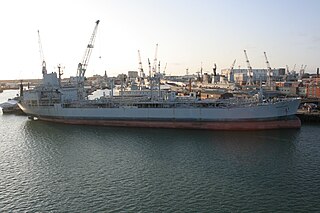Three ships of the Royal Fleet Auxiliary have borne the name RFA Brambleleaf:
RFA Bayleaf (A79) was a Leaf-class support tanker of the Royal Fleet Auxiliary, and the second ship to bear the name.

RFA Brambleleaf (A81) was a Leaf-class support tanker of the Royal Fleet Auxiliary. Originally built as MV Hudson Deep she was chartered by the Ministry of Defence in 1980.

RFA Cherryleaf (A82) was a Leaf-class small fleet tanker of the Royal Fleet Auxiliary, in service from 1973 to 1980.
The Mavroleon family is a Greek family of shipping magnates with strong United Kingdom connections.

London & Overseas Freighters Ltd. (LOF) was an ocean-going merchant shipping company that for most of its history was based in the United Kingdom.
MV London Statesman was a dry cargo ship built by Uddevallavarvet AB, Uddevalla in Sweden for London & Overseas Freighters (LOF). She was launched on 30 January 1963, completed on 26 June of that year and cost just over £1.3 million. LOF employed her on the tramp trade.
SS Michael E was a 7,628 GRT cargo ship that was built in 1941. She was the first British catapult aircraft merchant ship : a merchant ship fitted with a rocket catapult to launch a single Hawker Hurricane fighter aircraft to defend a convoy against long-range German bombers. She was sunk on her maiden voyage by a German submarine.
SS Primrose Hill was a British CAM ship that saw action in World War II, armed with a catapult on her bow to launch a Hawker Sea Hurricane. She was completed by William Hamilton & Co in Port Glasgow on the Firth of Clyde in September 1941.
SS Lulworth Hill was a British cargo ship completed by William Hamilton & Co in Port Glasgow on the Firth of Clyde in 1940. Lulworth Hill had a single 520 NHP triple-expansion steam engine driving a single screw. She had eight corrugated furnaces heating two 225 lbf/in2 single-ended boilers with a combined heating surface of 7,643 square feet (710 m2), plus one auxiliary boiler.
SS Kingston Hill was a cargo ship built by William Hamilton & Co in Port Glasgow on the Firth of Clyde. She was completed in December 1940. She was managed by Counties Ship Management Co Ltd of London (CSM), an offshoot of the Rethymnis & Kulukundis shipbroking company. She was a sister ship of SS Lulworth Hill, SS Marietta E, SS Michael E and SS Primrose Hill, which were also managed by CSM but owned by other R&K companies.
MV Tower Grange was a cargo ship completed by William Doxford & Sons Ltd in Sunderland in 1940. She was owned by Tower Steamships Co Ltd and managed by Counties Ship Management Co Ltd of London (CSM), both of which were offshoots of the Rethymnis & Kulukundis shipbroking company. Tower Grange was a sister ship of MV Putney Hill, which Doxford built in the same year for another CSM company, Putney Hill Steamships Co Ltd.
MV Putney Hill was a cargo ship completed by William Doxford & Sons Ltd in Sunderland in 1940. She was owned by Putney Hill Steamships Co Ltd and managed by Counties Ship Management Co Ltd of London (CSM), both of which were offshoots of the Rethymnis & Kulukundis shipbroking company. Putney Hill was a sister ship of MV Tower Grange, which Doxford built in the same year for another CSM company, Tower Steamships Co Ltd.
SS Marietta E was a British cargo ship completed by William Hamilton & Co in Port Glasgow on the Firth of Clyde in June 1940. She had a single 520 NHP triple-expansion steam engine built by David Rowan and Company of Glasgow, that drove a single screw. She had eight corrugated furnaces heating two 225 lbf/in2 single-ended boilers with a combined heating surface of 7,643 square feet (710 m2), plus one auxiliary boiler.
SS Gracechurch was a UK 4,318 GRT cargo ship built by William Doxford & Sons at Pallion on Wearside in 1930. She twice changed owners and names, becoming SS Peebles in 1933 and SS Mill Hill in 1936. She was sunk by a German submarine in August 1940.
SS Burgondier was a 5,297-ton cargo steamship built to a First World War standard design by Caird & Company at Greenock on the Firth of Clyde. She changed owners and names several times, becoming the Azul, David Dawson, Penteli and finally Brockley Hill. She was sunk by enemy action in 1941.
SS Canadian Constructor was a 7,178 GRT refrigerated ship built in 1922 by Halifax Shipyards Ltd in Nova Scotia.
Counties Ship Management Co. Ltd. (CSM) was an ocean-going merchant shipping company based in the United Kingdom. During the Second World War CSM merchant ships made a substantial contribution to supplying the British war effort, at a cost of 13 ships lost and 163 officers and men killed.
SS Glentworth was a shelter deck cargo steamship built in 1920 by Hawthorn Leslie & Co. in Newcastle-upon-Tyne, England for R.S. Dalgliesh and Dalgliesh Steam Shipping Co. Ltd., also of Newcastle-upon-Tyne. After the Great Depression affected UK merchant shipping in the first years of the 1930s, Dalgliesh sold Glentworth to a company controlled by Counties Ship Management who renamed her SS Box Hill.
SS London Valour was a British merchant ship belonging to London & Overseas Freighters (LOF). She was built as an oil tanker in England in 1956 and converted into a bulk carrier in Italy in 1966. She was wrecked in a gale just outside the Port of Genoa in 1970, resulting in the deaths of 20 of the 58 people aboard.


